- Home
- J. Clifton Slater
Serpent Circles Page 2
Serpent Circles Read online
Page 2
“It’s only the beginning,” the mountain man protested. “Every good tale starts with a beginning. Wait right there.”
Solomon stood and walked to one of the steamer trunks. After unbuckling the straps, he lifted the lid, reached in, and lifted out an object wrapped in an oily cloth.
“The oiled cloth isn’t to preserve it,” Solomon informed Tim. “It’s to keep the smell hidden.”
“Hidden? Hidden from what?” demanded Tim as he took the object. He sniffed as he unfolded the corners. “I don’t smell anything.”
“That’s because you don’t have a forked tongue that you smell with,” Solomon suggested. “And you aren’t searching for a relative.”
“Really Mr. Cooper, this is getting to be too much,” declared the researcher. “I should go.”
“Look at it,” ordered Solomon. “Describe it to me.”
“It’s a china dish of some sort with gold and red shading,” Tim said as he balanced the almost flat object on the palm of his hand. He studied it from several angles before adding. “Or possibly mica silicate stained to form an exotic ashtray.”
“Hold it up to the skylight,” instructed Solomon. “And tell me it’s man made.”
To satisfy the mountain man, Tim lifted his arm and gave the object a cursory glance. He started to lower it but stopped. Then he allowed the light to filter through the substance. He could make out wavy lines in layers running across the object.
“They appear to be growth ridges,” the historian said in surprise. “but that would mean…”
Researcher Tim Constance didn’t have the words, or maybe he didn’t have a prospective on size for a comparison.
“Here, use this,” Solomon offered as he pulled a snakeskin belt from around his waist. “It will give you a hint of what I was up against.”
The tiny snake scales on the belt resembled the plate in shape and color. But, while one could fit on the tip of Tim’s little finger, the other covered his entire hand. After examining them further, Tim handed the snake scale and belt back to Solomon.
“Please continue,” Tim encouraged the mountain man as he turned on the recorder.
“Let me put this away before I get another hole in my house,” Solomon stated.
Tim glanced over his shoulder at the new patch on the wall. Then he looked at the barbed metal egg in the center of the room.
“Safe room?” he mumbled as Cooper came back and sat.
“Where was I?” Solomon asked before answering himself. “That’s right, school.”
Chapter 3 - The Education of a Slayer
In the fall, I said goodbye to my father and the miners on his crew and left for school. Where I had been a distracted student, that year I doubled down on my science classes. Textbooks on reptiles of every type were added to my reading. And I took martial arts classes, specifically instructions with edged weapons. Learning to calm my nerves in the face of danger was my main goal. Little did I realize the mental discipline would eventually become my greatest weapon.
When spring arrived, I left school with plans to return to Crusty Boy. But fate and my mother had other plans. She bought two tickets for a world cruise and dragged her snake hunting son along as her companion.
One good thing came from that summer of travel. As the ship docked at a working port in the southern islands, I watched hunters use harpoons on sharks and sea crocodiles. The speed and power of their thrusts amazed me.
One afternoon while in port, I slipped away from a tour group. My poor mother contacted the local authorities and the cruise ship representative to search for her kidnapped offspring. They found me when the fishing boat docked and I stood on the bow holding the head of a sea croc. I’m not sure which shocked my mother more. My sudden arrival or my blood covered appearance. For the rest of the cruise, she kept me by her side. When we returned from the trip, I headed back to school.
In hindsight, the two years at school and the summer between them probably saved my life. I grew taller, put on muscle, and learned a lot more about snakes. For example, snakes don’t actually hibernate. What they do is slow down their metabolism when it’s cold. While most of the studying proved useful, that piece of information almost cost me my life.
Armed with a longing for the woods and the snake hunt, I caught a train for old Bedford on the last day of school. And it’s a good thing I did.
***
In the two years I was away, very few snakes crawled into Crusty Boy. Unfortunately, a mine over the mountain and far down in another valley brought four guard dogs to keep the animals, rodents, and snakes away from the Abram Company mining operation.
I arrived like a spring rain, swept through Crusty Boy, and climbed into the hills leaving the noise, dirt, and roar of the equipment behind. Armed with a bigger hunting knife, my rifle, a flashlight, and thick gloves, I started where I’d first seen the juvenile nadreddets.
The morning air was cool despite the warm sun. I searched the surrounding hills looking for a snake hole or a cave. Hours later, I came upon a wide fissure. Having learned that snakes were sluggish in cold weather, unafraid, I squeezed into the gap and emerged in a small cave. Bent over, I crept deeper in while shining the beam ahead of me. When I saw six baby snakes in a nest, I pulled my knife.
You might think beheading tiny snakes was easy. It’s not. Their scales and skin are tough and due to the low ceiling, I barely had enough room to work. They were lethargic from the cold and moved very little as I chopped and hacked until six fanged heads were separated from their bodies. I paused in the stale air to catch my breath. Then the twelve parts began to squirm. Mimicking the movements of inch worms, the heads and bodies squirmed deeper into the cave.
During my studies, I read about posthumous movement. It involved nerves sending signals to the spinal cord and triggering muscles causing twitching and even jumping by some reptiles. Without the brain, it shouldn’t be directional, or in the case of the dead snakes, a migration deeper into the cave.
Equipped with the knowledge that snakes were listless in the cold, I followed. When the roof lowered, I dropped to my knees and shuffled forward. With one hand holding the flashlight, my progress was slow as I placed my other hand on the floor of the cave and brought each leg up in turn. Because of my awkward crawl, the beam of light flickered around from the ceiling to the sides and the floor of the cave. Rarely did the light shine straight ahead. If it did, I failed to pay attention.
Suddenly, the black hole in front of me widened as the ceiling and sides vanished. I’d reached a cavern. While preparing to stand, I flashed the beam upward to judge the height. Then a hiss filled the space and I aimed the flashlight’s beam directly forward. I was petrified with fear at the sight.
It must have been eight feet long, although it was difficult to judge length with its body coiled. But there was no guesswork in gauging the size of the snake’s head. As big as a football with four-inch fangs dripping a thick liquid, the nadreddet flicked out it’s forked tongue and caressed my cheek. The touch sent a shock through my body releasing me and sending me into a flurry of activity to save my life.
I dropped the flashlight, pulled my knife, and ran the blade up and through the snake’s body. My intention was to stab through the head and into the brain. But at the time, I was incapable of having a coherent thought. It was dumb luck that my reflex action impaled the nadreddet just behind its head. With the fangs scraping the back of my gloves, I twisted the blade and yanked it to the side. The sharp edge of the hunting knife cut through the vertebrae, ripping skin and scales as it sliced the thick body in half. Without thinking, I brought the blade back across and sliced more of its flesh. Five strokes later the coiled body lay still as the big head tumbled to the floor of the cavern.
While trying to catch my breath, I reached down for my flashlight. In the beam, I noticed a nest of snake eggs. There must have been fifty and I decided to crush them to prevent the hatching of more nadreddets. I had the knife posed over the nest when another hiss,
louder than the first, came from deeper in the cavern. My nerves failed me and I retreated. As I crawled backward, the flashlight’s bean zipped over the dead snake. Before I lost it in the dark, I swear, I saw the body and the head move.
Once out of the cave, I walked downhill toward Crusty Boy, too exhausted and spent to rush.
***
That night at Wakeman's Lodge, I could barely eat. My nerves were frayed and memories of the snake coming out of the dark kept my heart thumping in my chest. I’d have to be careful in the future if I wanted to survive. None of the crew noticed me picking at my food except the old story teller. Tobiah studied my face as I rolled peas across my plate. Then he dug into a pocket, pulled out a piece of paper, and handed me a note. It seemed the four guard dogs at the Abram Company mine had gone missing. Fearing an aggressive pack of wolves or some other predators were hunting near their mining operation, the manager posted a job listing for a tracker.
I jumped up from the table, raced to a phone, and called the manager. After lying about my age and experience, the manager hired me. I went back to the table, finished the meal, and had seconds. In the morning, I caught a ride off the mountain on an ore truck. He dropped me at a crossroad. From there, I hitched a ride with another truck to the valley where the Abram Company Mine was located. It was the start of a career that would consume me and end in failure.
***
“So, you were a hunter for the mines,” ventured Tim Constance as he turned off the recorder. “That explains why you remained in the mountains. It’s that kind of experience I need to know about. Specifically, your history dealing with Crusty Boy.”
“Did you not listen when I told you. I was a nadreddet slayer,” the mountain man said in frustration. “Anyone can hunt wolves, puma, bears, or deer. Sure, I was hired to find out what happened to the dogs and to eliminate the threat of predatory animals. But the hunt changed shortly after I arrived at Abram.”
In the face of Solomon’s intensity, Tim reached out and clicked on the recorder. It was better to listen and record than challenge what might be a slightly insane individual.
“Please go on,” the researcher urged. “I didn’t mean to interrupt.”
Chapter 4 - Tracks, Trails, and Ouroboros
The Abram operating area was massive with three separators and three narrow-gauge sets of tracks leading into three holes in the mountain. And, unlike Crusty Boy where none of the crews stayed after their shift, it had barracks and a dining hall. I reported to the manager to get the paperwork done. He offered me a bed for the night, but the sun was high overhead. I passed on the proposed accommodations. Instead, I went to the cook, filled my backpack with supplies, and marched to the edge of the leveled off rocks and dirt. Once I located the path used by the guard dogs, I trekked into the woods.
On the first day, I decided to mark down game sightings. Figuring if a pack was hunting, their prey would vacate the immediate area. As I hiked, I made notes. Three days later, I dropped out of the woods on the other side of the Abram operating area.
“I’ve scouted the sectors around your operation,” I described to the manager. As I talked, I marked animal sightings and my route on a map. “I couldn’t find any trace of the dogs or tracks from puma, wolves, or bears. There might have been but, they seem to have left. I’m confident there are no predators close to your mine. If you’ll get my pay, I’ll head back to Wakeman's Lodge.”
“After what happened at Crusty Boy, having you out there hunting gives my crews peace of mind,” the manager informed me. “Would you take a year’s contract to continue to hunt for Abram.”
And just like that, I had a paying job. The next day, I gathered my supplies and marched back into the forest. This time, I enlarged the search area. One reason was to earn my pay. The other gave me time to hunt snakes.
I was out for five days on that hunt. Upon returning to Abram, I logged the route and animal sightings on the map. As I made the notes on the paper, a pattern emerged. The number of animals was constant for most of the canvassed area. But almost as if someone drew a wide arrow, starting from a narrow band above Abram and expanding as it climbed the mountain, the number of large animals dwindled to almost none. It hit me, the deserted strip pointed up the mountain in the direction of Crusty Boy.
***
I set out the next morning to scout the boundaries of the cleared area. Again nothing. I mean no large animal tracks were anywhere. And surprisingly, there were few small animal sightings in the center of the strip. Taking my time, I searched from one side to the other as I went up the mountain. Late in the day, I setup camp planning to get an early start on the steeper slopes. I awoke to sprinkles and was tempted to stay in my dry tent until it passed. But the mysterious disappearance of animals nagged at me. I crawled out of the tent, packed up my equipment, and started up the mountain.
The light drizzle mixed with my sweat making me as damp as the vegetation on either side of the footpath. And the hiking grew more difficult the higher I climbed. Using animal trails helped a little. They crisscrossed the steep grade following the contour of the mountain as it rose in elevation. By midday, I grew weary from following the long looping trail but continued to trudge up the hill.
It wasn’t until I passed through the fog of low clouds and felt the warmth from sunlight filtering through the trees that I decided to rest. Shrugging one strap off the backpack, I let it hang as I looked around for a spot to prepare a meal. Then I saw signs of animals passing and became invigorated. Quickly, I shouldered the pack and marched forward to investigate.
Hoof tracks of a doe and a fawn were stomped into the dry trail. The pair had come from the woods and taken the path upward. This was the first sign of large animals I’d seen for a few days. A desire to get close to the deer and observe them overcame my fatigue. I followed their trail.
Half an hour later, the path rounded a rock outcrop and I froze. On the other side was a field. Almost flat, the small basin, probably formed by an ancient rock slide, was covered by green mountain grass. It wasn’t the sight of the pasture that caused me to stop. It was the presence of two enormous snakes.
One had his jaw open with the legs of the fawn, still kicking, hanging from its mouth. Another had the head and shoulders of the doe engulfed in the enormous orifice. Both flexed as they swallowed to draw the living prey into their stomachs. Horrified, I stood watching the monsters dine. This was the cause of the missing wildlife, I realized. But the sight grew more bizarre when I spotted a third nadreddet on the far edge of the field.
It was smaller by comparison but still an immense reptile. The gold and red snake was also busy eating. And like the others, it flexed, bit down, and pulled the flesh deeper in. With each movement, acid saliva coated the living flesh easing the passage of the meal into its stomach. But this snake had no prey. It dined on its own tail.
I pulled the long gun off my shoulder and chambered a round. Then, I stopped. The mass of the nadreddets compared to the weight of a bullet from my bolt action rifle didn’t assure me of a kill. While I pondered my next move, the raw tail flopped out of the snake’s mouth and the head turned in my direction. The tongue flicked at me and the skinless tail with a few clinging scales wiggled in the grass.
I don’t suffer from ophidiophobia. However, at the moment, it wasn’t irrational to fear snakes. Especially when one the size of the nadreddet came slithering through the grass in my direction. Flight or fight kicked in and I selected run.
At first, I stayed on the trail. But each time it doubled back, I imagined the snake waiting to strike from the bushes. To avoid the fangs, the poison, and the saliva, I plunged off the path and tumbled down the mountain.
In my flight, I lost my rifle and my backpack. Both are still up there somewhere far from any of the game trails. When daylight faded, I travelled throughout the night. Every moonlit vine or shrub tree resembled a snake. I fell off low cliffs and bumped into trees as I careened downhill. By the time I reached Abram, I was cut up, limping, a
nd exhausted.
***
When I told the manager about witnessing giant snakes eating whole deer, he became angry. After firing me for being unhinged, he paid me a bonus to keep me from repeating the fantasy and frightening his crews.
I took the severance pay, kept my mouth shut, and caught a ride to Wakeman's Lodge. I didn’t tell anyone there either. No one would have believed me and I was afraid my father would send me to live with my mother if I repeated the story. While I didn’t venture into the mountains for the rest of that summer, I did prepare.
***
Turning off the recorder, Tim Constance looked hard at the mountain man as if trying to judge his sanity.
“The Ouroboros is a symbol of the eternal unity of all things,” the researcher explained. “Or the cycle of birth and death. But it’s a mythical symbol and, as far as I know, not practiced by any species. Yet, you claim to have seen one.”
“A snake eating its own tail,” Solomon assured him. “And not just once.”
“Mr. Cooper, I’m not sure we can continue,” Tim admitted. “This interview had gone off into some dark place in your imagination. I really should be going.”
Solomon stood and walked to the sword and shield. He pulled both items off the wall and carried them back to the sitting area.
“This sword was forged during the summer of that year,” Solomon informed the researcher. Then he lifted his shirt and pointed to matching scars on his ribs. “These were inflicted before I had the presence of mind to cast the shield.”
The historian leaned forward to get a better view of the scars. Two lines, as if the skin had been raked by two sharp tips, extended from just under his armpit to the floating rib. Although the parallel scars could have been from an industrial accident, the skin on either side resembled melted wax. But there were no burn marks or tight skin patches visible as one would expect from a fire or electrical injury.
“It must have been painful,” Tim remarked trying to appease the man.

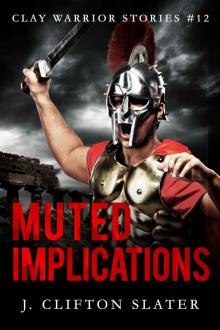 Muted Implications (Clay Warrior Stories Book 12)
Muted Implications (Clay Warrior Stories Book 12)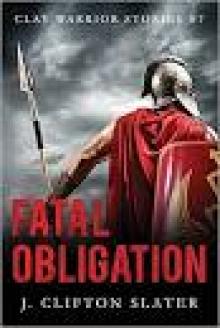 Fatal Obligation
Fatal Obligation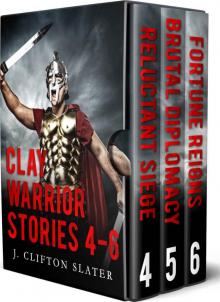 Clay Warrior Stories Boxset 2
Clay Warrior Stories Boxset 2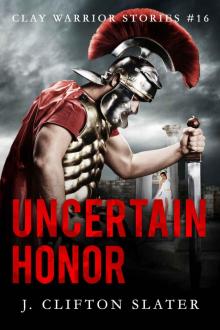 Uncertain Honor
Uncertain Honor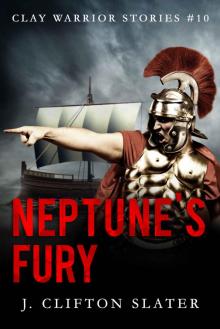 Neptune's Fury
Neptune's Fury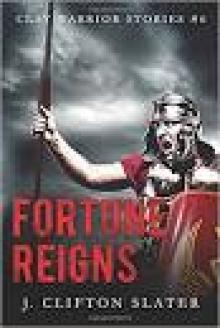 Fortune Reigns
Fortune Reigns Op File Treason
Op File Treason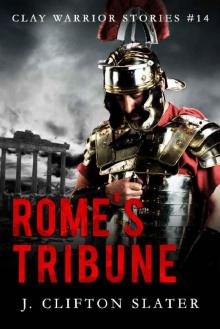 Rome's Tribune (Clay Warrior Stories Book 14)
Rome's Tribune (Clay Warrior Stories Book 14)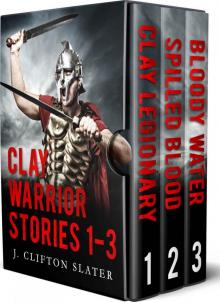 Clay Warrior Stories Boxset 1
Clay Warrior Stories Boxset 1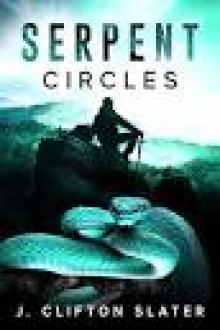 Serpent Circles
Serpent Circles Reluctant Siege
Reluctant Siege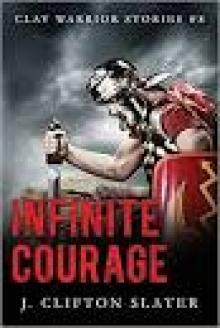 Infinite Courage
Infinite Courage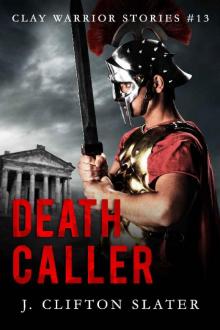 Death Caller (Clay Warrior Stories Book 13)
Death Caller (Clay Warrior Stories Book 13) Op File Sanction
Op File Sanction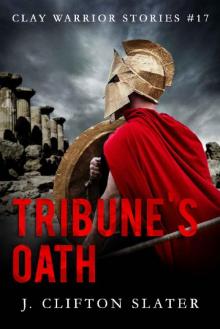 Tribune's Oath (Clay Warrior Stories Book 17)
Tribune's Oath (Clay Warrior Stories Book 17)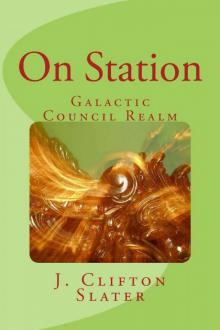 Galactic Council Realm 1: On Station
Galactic Council Realm 1: On Station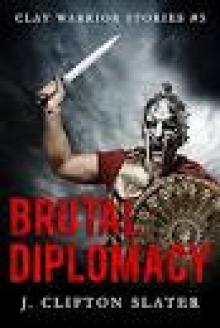 Brutal Diplomacy
Brutal Diplomacy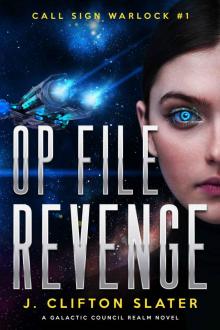 Op File Revenge
Op File Revenge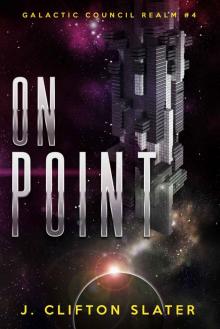 On Point
On Point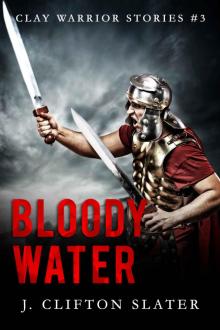 Bloody Water (Clay Warrior Stories Book 3)
Bloody Water (Clay Warrior Stories Book 3)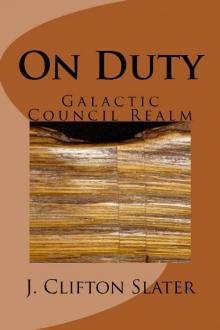 Galactic Council Realm 2: On Duty
Galactic Council Realm 2: On Duty Galactic Council Realm 3: On Guard
Galactic Council Realm 3: On Guard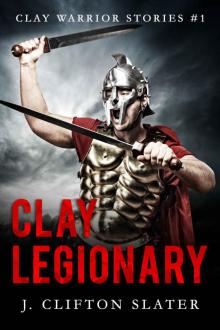 Clay Legionary (Clay Warrior Stories Book 1)
Clay Legionary (Clay Warrior Stories Book 1) On Point (Galactic Council Realm Book 4)
On Point (Galactic Council Realm Book 4) Op File Revenge (Call Sign Warlock Book 1)
Op File Revenge (Call Sign Warlock Book 1)